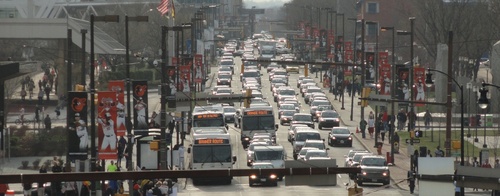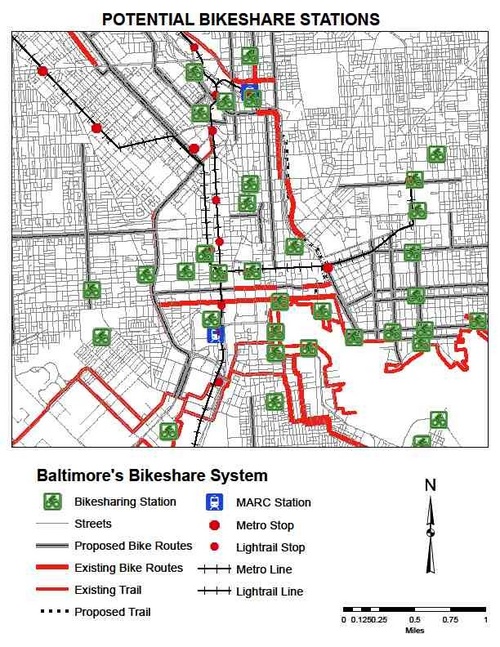Baltimore starts building a real bicycle network
Baltimore transportation officials have proposed a “network of bicycle infrastructure,” including the city’s first-ever cycletrack. It’s a big leap beyond today’s incongruent sharrows and paint.
The cycletrack will stretch 2.6 miles along Maryland Avenue and Cathedral Street, from Johns Hopkins University in the north to the convention center near the harbor. It will be installed this fall. For the city’s bicycle advocates, the network represents a hope that Baltimore may start to build bicycle infrastructure on par with Washington and catapult bicycling forward in the central business district.
Will the Downtown Bicycle Network actually serve downtown?
While its name is the “Downtown Bicycle Network,” the projects are mostly actually in Mt. Vernon, a neighborhood north of the central business district. The cycletrack will get a bicyclist downtown, but for now that is where the network ends.
A Pratt Street cycletrack could provide an east/west complement to the north/south Maryland Avenue cycletrack.
Pratt Street is the main artery of the business district. Because of its width and concentration of businesses, hotels, tourist attractions, facilities like the convention center, institutions like the University of Maryland, it remains the grand prize for a cycletrack. Bikemore, Baltimore’s bicycle advocacy organization, is pushing this idea.
Officially, Baltimore’s bike map lists bus/bike lanes on Pratt Street. However, these lanes are not often enforced and not comfortable for many bicyclists.
Some maps and officials also consider the Inner Harbor Promenade and the Jones Falls Trail adjacent to Pratt Street as bike facilities. But in summer, they are often packed with tourists, strollers, pedestrians, and are often impassable for bicyclists.
If not for Bixi’s financial troubles, it is likely Baltimore would have a bikeshare system by this summer. Hopefully, Baltimore can use the delayed launch to continue to build a better network to support cycling. The better the infrastructure, the better bikeshare will work when it eventually launches.
Baltimore can learn from DC and Pittsburgh
Washington is not the only nearby city for Baltimore to seek inspiration. Pittsburgh has integrated quality bike facilities along its waterfront and made connections to nearby neighborhoods. In a Pittsburgh Magazine article about the steel city’s revitalized riverfront, Lisa Schroeder, president and CEO of Riverlife, likens the increased traffic along the riverfront to the growth of the regional trail network.
“The more trail that was created, the higher the number of users,” she said. “We hit that momentum point along the rivers this year. People realized, ‘Aha — this is a network, and I can go in all directions.’” Bill Peduto, Pittsburgh’s new bicycle-friendly mayor wants his city to be in Bicycle magazine top ten US cities, despite its hilly contours.
Will the Maryland Avenue cycletrack be the first of a series of complementary projects, extensions, and improvements to Baltimore’s bicycle network? The fast growth of DC’s and Pittsburgh’s networks make us optimistic that the Charm City will soon catch the momentum too.



